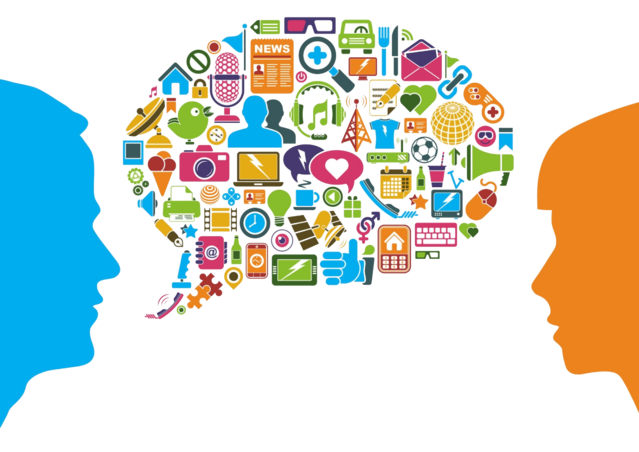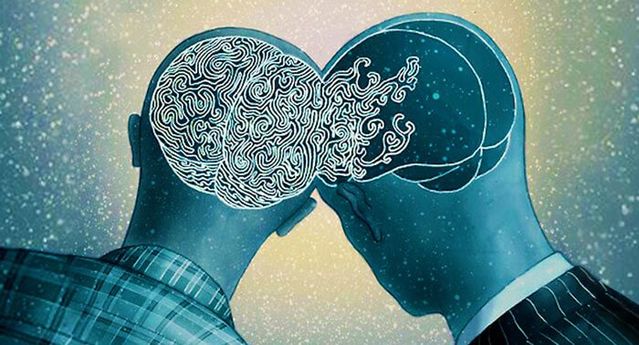Career
How Does Communication Work?
Part 1: The role of non-verbal cues.
Posted January 17, 2020 Reviewed by Devon Frye
First impressions matter. When we meet someone new, we seldom remain neutral: good or bad, we form an immediate opinion of them—too brash, too boring, engaging, drab, shy, and so on. This is, in large part, based on non-verbal cues—their appearance, body language, and mannerisms—rather than what they say. We use these cues to form an emotional response that informs the way we view the other person. And we do all this in just a tenth of a second!

In some contexts, first impressions are of the utmost importance, as when chatting with a prospective date—who might, eventually, become your life partner (or not, as the case may be). As for the dreaded job interview, sage advice invariably counsels that we come across well from the outset, that hiring decisions are often decided within the first few minutes.
This is more than mere folk wisdom: it’s backed up by scientific research. In one leading study, researchers examined hiring decisions based on a survey of 600 thirty-minute interviews. They found that around 5 percent of decisions, whether to hire or not, were made in the first minute; around a quarter of decisions in the first five minutes; and a whopping 60 percent within the first fifteen minutes. Before an interview is even halfway through, and before you’ve managed to get to grips with those butterflies in your stomach, your fate may already be sealed.
In our everyday encounters, how we respond to others is, in large part, determined by how we respond to them emotionally. We give up our seat on the bus or the train because we recognise and empathise with the greater need of others—the elderly, disabled, or the clearly exhausted mother-to-be. We respond positively, in a humdrum service encounter, to the employee with the winning smile and polite turn of phrase, and negatively to the ill-mannered youth who bumps past us in the street.
Communicating Empathy
Empathy is a key factor in understanding others, and a central ingredient in deriving meaning from social interactions. And this appears to arise, in large measure, from the non-verbal cues that abound in our everyday social encounters.
While empathy, in its most rudimentary form, is often understood as an awareness of the feelings and emotions of others, it involves more than this. According to a leading expert on emotional intelligence, empathy is an "awareness of others’ feelings, needs, and concerns," and requires "sensing others’ feelings and perspectives, and taking an active interest in their concerns." Oxford Dictionaries defines empathy as: "The ability to understand and share the feelings of another."

So how do we form our experiences of others? How do we actually "experience" the experiences of others, in order to demonstrate a sensitivity to and, indeed, an active interest in their concerns? How do we get to stand in their shoes, so to speak, to get to grips with what they are about, and more importantly, what they mean, in everyday communication?
Verbal cues—the words we string together in spoken utterances—are only part of the story. Of course, it stands to reason that in certain contexts, what others say, using language, is the key ingredient in meaning-making: in a public lecture, for instance, the message is largely conveyed by the words. Sure, we can gain a lot of information from the speaker’s body language; but the content, the message, is right there in the words they’ve chosen for their talk. Yet, in our daily face-to-face interactions with strangers, family members, work colleagues and friends, we respond to a far greater degree to non-verbal information.
Verbal vs. Non-Verbal in Social Dimensions of Communication
On one estimate, only 30 to 35 percent of the social dimensions of meaning—such as our emotional expression, our personality and how we relate to others—come from language; in our daily interactions with others, up to a staggering 70 percent may derive from non-verbal cues. This includes the visual cues such as the other person’s body language, facial expression, and gestures, as well as how close they stand to us—we’ve all experienced the discomfort of the individual who occupies too much of our personal space; our emotional response is likely to be negative.
We also respond to their physical appearance, their dress, as well as the environment in which we encounter them, which provides information about their occupation or mode of living. We also draw information from touch—I once knew a successful businessman who claimed to be able to tell how reliable a potential partner or client was from how they shook his hand. But is there any truth to this anecdote?
According to research, there really is: the strength of our handshake gives away tell-tale signs about our personality. In one of the first studies of its kind, researchers investigated the relationship between handshake strength and personality. In the study, 112 subjects shook hands with four trained coders—twice with each coder—in order to assess grip strength of the handshake. The subjects also completed assessments of personality traits.
The research found that a strong handshake, across both sexes, correlates with being an extrovert and emotionally expressive. In contrast, a weak handshake tends to correlate with introversion and being less emotionally expressive.
We derive further information from observing self-touch: someone touching their hair might be bored, or perhaps even signaling romantic interest. We also glean information from how others manage the ongoing, smooth flow of conversation (time between turns in an exchange), as well as eye contact, pupil dilation (especially in assessing the likelihood of a potential romantic encounter) and even blink rate.
Kinesics: The Science of Body Language
All these dimensions of non-verbal communication were studied by the late American anthropologist Ray Birdwhistell, a pioneering figure in this area of research. He founded the field of kinesics, as he dubbed it, which involved the study of the role of "facial expression, gestures, posture and gait, and visible arm and body movements" in conveying social meaning.
Viewed through this lens, it is perhaps no accident that digital forms of communication, such as Emoji, with its bewildering array of yellow faces, ranging from the assorted permutations on a smile through to the various confused, unamused, sad and angry faces, is so apt for visual communication in textspeak.
Paralinguistics: The Science of Tone of Voice
The other dimension of non-verbal communication involves paralinguistic features of speech, first studied by the American linguist Alfred Trager. Paralinguistics is the study of the features that accompany spoken language, as a consequence of its medium of production, and which can influence and even alter the meaning of the words we utter.
Paralinguistic features range from vocal signals, such as laughter, to speech prosody, which includes rhythm, relative volume, pitch, intonation, and the pitch range the voice operates in—higher for women, on average, than men. Prosody derives from the ancient Greek meaning "song sung to music." Spoken language has a musical quality associated with it. And this derives from the way it is produced via the articulators, such as the tongue, mouth, lips, and the vibrating folds in our voice box, as well as the musculature that we use to control the articulators.
While the prosody of our own language can seem like music to our weary ears—especially after a prolonged absence abroad, struggling, disadvantaged and ill at ease with a foreign tongue you might mangle (at best)—the absence of prosody can lead to the perception of someone’s speech being monotonous, perhaps even sinister. This is famously evidenced by the morally and emotionally ambiguous Professor Snape, played by the late, great Alan Rickman, in the Harry Potter movies.
For some, animating their spoken language seems a challenge—as a young student, I once had the misfortune to be taught by an otherwise erudite and knowledgeable professor who seemingly possessed the ability to send his students to sleep; watching paint dry would have been more entertaining. But in fact, there is a clinical condition that afflicts some people who are unable to correctly modulate their speech. This is known as aprosodia; it results in an impairment in properly varying pitch, loudness, rhythm and intonation—such as the rise and fall of speech contours—during speech. Sufferers not only sound flat and monotonous when they speak, they are also unable to convey emotion in spoken language or infer the emotions of others as conveyed during spoken interaction.
Aprosodia is sometimes evident in people afflicted with Asperger’s syndrome. This reveals just how essential prosody is to communication: it’s one of the key ways in which we convey information that helps our addressee to empathise with us in spoken interaction. It provides a direct means of signaling our emotional stance and our attitude, as well as placing focus on specific parts of words, entire words, and phrases.
The Face As the Barometer of Our Emotional Selves
In the American TV crime drama Lie to Me, the British actor Tim Roth plays Dr. Cal Lightman, a world-leading authority on facial expressions. Lightman and his team accept assignments from federal and local law enforcement agencies that require their expertise; Lightman and his associates are second-to-none in detecting whether a suspect is lying during interrogation, by studying their facial expressions and body language and what these reveal about their emotions.
The TV series is based on a branch of applied psychology, made famous by the American forensic psychologist Professor Paul Ekman, dubbed the "best human lie detector in the world." Ekman pioneered the study of emotional expression by developing a technique for studying micro-expressions—fleeting facial features. There are over 10,000 of them, produced by up to forty-three facial muscles when we experience joy, anger, sadness, guilt, and disgust.
Ekman developed a facial coding system that allows videotaped interviews to be analysed by sophisticated software systems. The system uses the geometrical features of a subject’s face in order to help detect whether they are telling the truth or not. This expertise led to Ekman becoming one of the twentieth century’s most widely cited psychologists. His prowess also ensured that those with a vested interest in deciphering emotions from facial expression beat a path to his door—Ekman has worked as a consultant to police departments, anti-terrorism agencies, as well as the Lie to Me production team.
If the eyes are the window to the soul, then the face is a barometer of our emotional selves. Nowhere is this clearer, perhaps, than with the forty-fifth President of the United States, Donald Trump, whose facial expressions often reveal how he feels on a given subject. In an analysis commissioned by The Guardian, psychologist Peter Collett examined the seven signature facial expressions of Donald Trump, providing insight into the president’s emotional self. From the alpha face, to the chin-jut, to the zipped smile, Trump’s face broadcasts how he feels, and what he wants us to think and feel along with him.




